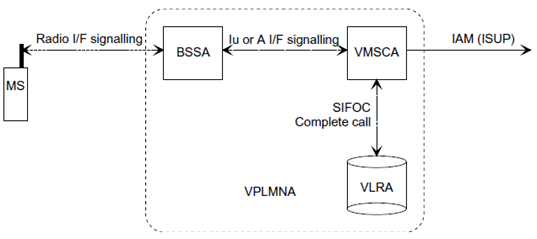Content for TS 23.018 Word version: 18.0.0
4 Architecture
4.1 Architecture for an MO call
4.2 Architecture for an MT call
4.3 Architecture for a TO call
...
...
4 Architecture |R5| p. 11
Clauses 4.1 and 4.2 show the architecture for handling a basic MO call and a basic MT call. A basic mobile to mobile call is treated as the concatenation of an MO call and an MT call.
4.1 Architecture for an MO call p. 11
A basic mobile originated call involves signalling between the MS and its VMSC via the BSS, between the VMSC and the VLR and between the VMSC and the destination exchange, as indicated in Figure 1.
In Figure 1 and throughout the present document, the term BSS is used to denote a GSM BSS or a UTRAN, as appropriate.

In Figure 1 and throughout the present document, the term ISUP is used to denote the telephony signalling system used between exchanges. In a given network, any telephony signalling system may be used.
When the user of an MS wishes to originate a call, the MS establishes communication with the network using radio interface signalling, and sends a message containing the address of the called party. VMSCA requests information to handle the outgoing call (SIFOC) from VLRA, over an internal interface of the MSC/VLR. If VLRA determines that the outgoing call is allowed, it responds with a Complete Call. VMSCA:
- establishes a traffic channel to the MS; and
- constructs an ISUP IAM using the called party address and sends it to the destination exchange.
4.2 Architecture for an MT call p. 12
A basic mobile terminated call involves signalling as indicated in Figure 2. Communication between VMSCB and the MS is via the BSS, as for the mobile originated case. If VPLMNB supports GPRS and the Gs interface between VLRB and the SGSN is implemented (see TS 23.060) and there is an association between VLRB and the SGSN for the MS, the paging signal towards the MS goes from VMSCB via VLRB and the SGSN to the BSS. The IPLMN, containing GMSCB, is in principle distinct from HPLMNB, containing HLRB, but the practice for at least the majority of current UMTS or GSM networks is that a call to an MS will be routed to a GMSC in HPLMNB.

When GMSCB receives an ISUP IAM, it requests routeing information from HLRB using the MAP protocol. HLRB requests a roaming number from VLRB, also using the MAP protocol, and VLRB returns a roaming number in the Provide Roaming Number Ack. HLRB returns the roaming number to GMSCB in the Send Routeing Info ack. GMSCB uses the roaming number to construct an ISUP IAM, which it sends to VMSCB. When VMSCB receives the IAM, it requests information to handle the incoming call (SIFIC) from VLRB, over an internal interface of the MSC/VLR. If VLRB determines that the incoming call is allowed, it requests VMSCB to page the MS. VMSCB pages the MS using radio interface signalling. When the MS responds, VMSCB informs VLRB in the Page ack message. VLRB instructs VMSCB to connect the call in the Complete call, and VMSCB establishes a traffic channel to the MS.
4.3 Architecture for a TO call |R7| p. 13
A basic trunk originated call involves signalling between the PSTN and the PLMN's MSC, as indicated in Figure 4.3.1. The originating exchange may also be another MSC of the same or different PLMN.
The MSC may also be connected to PBX but that is outside the scope of this document. In the PBX case same modelling applies but the PBX signalling is different to ISUP.

In Figure 4.3.1 and throughout the present document, the term ISUP is used to denote the telephony signalling system used between exchanges. In a given network, any telephony signalling system may be used.
The MSC receives a setup (IAM) message from the originating exchange. The MSC analyses the called party number and routes the call to an appropriate destination. If the called party number is an MSISDN the gateway MSC functionality is activated. If the MSISDN belongs to another PLMN (or is ported out), the call is routed to another PLMN. If the called number is a PSTN number then the call is routed to (appropriate) PSTN operator. There may be other destinations also.